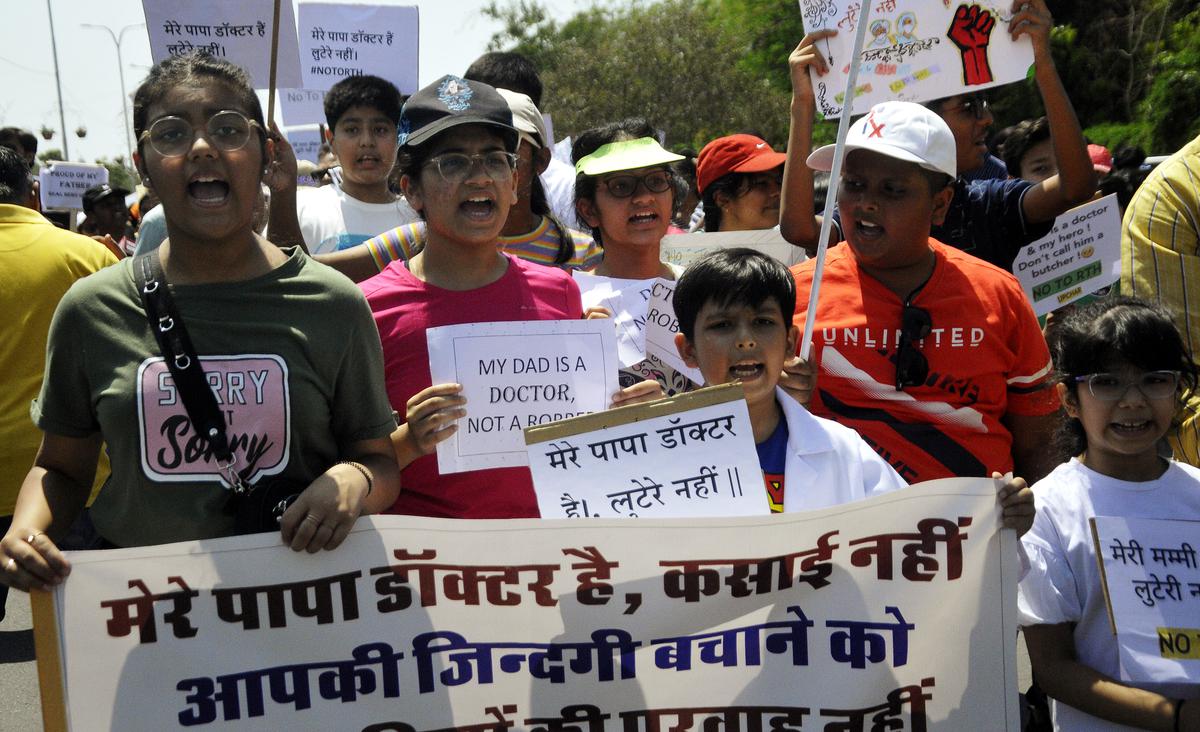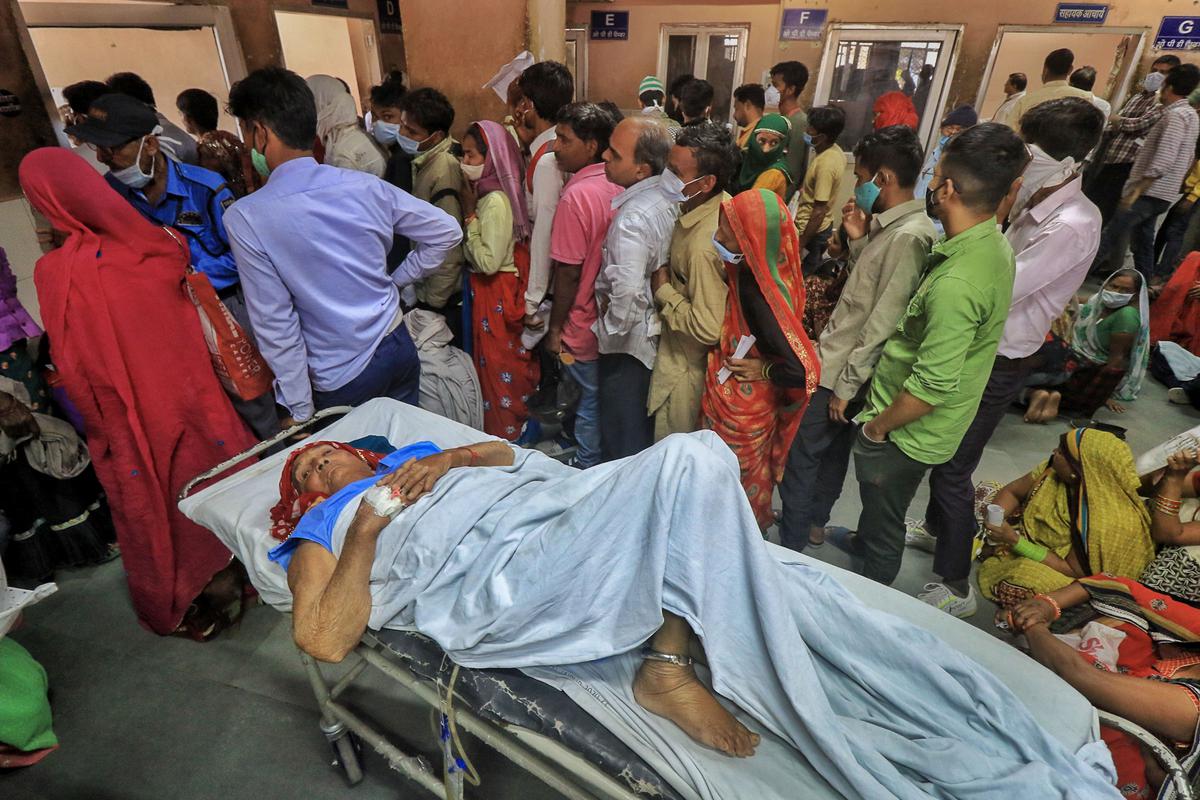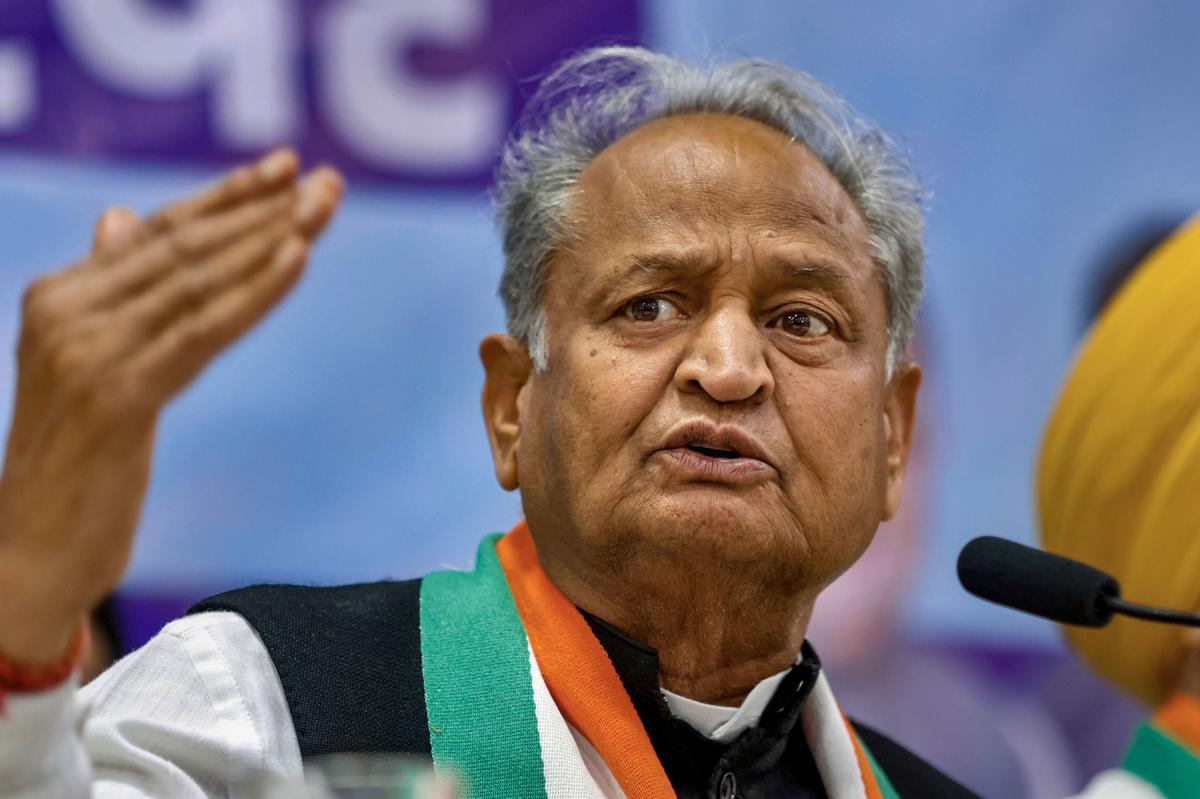In India’s government hospitals, where the wards are overcrowded, and people, sometimes unlettered, always overwhelmed, come from the smallest villages, bed numbers are all important for reference.
On bed no. 11 in one of the intensive care units of Jaipur’s Sawai Man Singh (SMS) Hospital, a 6,000-bed State-run and -funded unit with 43 wards, that sees 15,000 patients every day, Vipin, 16, lies dwarfed by all that’s happening around him. When his bike skidded on a road in Alwar, in December 2022, his family rushed him to Jaipur to be treated at a private hospital.
His father, Mukesh Chaudhary, a farmer, had undergone an ENT surgery just before his son’s accident. Besides the trauma of a child almost losing his life, Mr. Chaudhary borrowed ₹6 lakh to pay for the less-than-month-long treatment. Having run out of funds, the family shifted Vipin to SMS Hospital. Mr. Chaudhary had already shelled out ₹1.5 lakh for his own operation, and so had to borrow money from his brother-in-law.
When the Rajasthan Right to Health (RTH) Bill is fully operational, people such as Mr. Chaudhary will get treatment free of cost, with some terms and conditions. The government will reimburse the private hospital, and people like Mr. Chaudhary will only have to attend to the needs of their kith and kin.
As per the National Crime Records Bureau data, over 10,000 people died in road accidents in the State in 2021. Those who survive are often saddled with debts. A report published by the Public Health Foundation of India in 2019 says that about 55 million Indians were pushed into poverty in a single year due to healthcare costs.
The RTH Bill focuses on access to healthcare, and guarantees several rights to patients, including privacy, dignity, and control over their health records, but what triggered the 16-day strike by doctors was the attempt to bring private healthcare enterprises into the circle.
Private sector doctors — there are 9,615 of them, across 1,200 establishments — alleged there was no clarity on what is ‘emergency’ and which hospitals could be drafted for the operation of the law. Chief Minister Ashok Gehlot’s government bought peace with the striking doctors by removing hospitals and clinics with less than 50 beds out of the RTH ambit, initially. ‘Relief’ has now been given to establishments that have not taken any kind of government subsidy.
Rajasthan has a primary healthcare centre (PHC) every 10 km (except in the desert districts like Churu). There are 2,265 PHCs across Rajasthan, and 151 beds available for a population of one lakh (better than Uttar Pradesh and Kerala), and 12 community health centres for a 10 lakh population, but specialised care is available at a distance of 50 km to 80 km, according to data provided by the government.
Dr. Prithvi Raj, Rajasthan’s Health Secretary, explaining the need for bringing the private sector into the picture, says: “The plan was that the State would pay these private providers — for giving patient healthcare services at reasonable rates and meeting quality standards — once they have saved the lives, and the patient is stabilised….”
This is not the first time the Rajasthan government is trying to rope the private sector into mandatory health services. Under the existing Mukhya Mantri Chiranjeevi Swasthya Bima Yojana , the universal health coverage scheme, 1.39 crore families have been insured for ₹25 lakh. Over two years, the State government has disbursed ₹4,153 crore to 899 private establishments, covering 37 lakh patients.
While some of the concerns about definitions are valid, and the government is open to further changes, what may be disrupting the business model of private healthcare is the implied price regulation. For instance, a private facility charges ₹2,500-₹3,000 for a dialysis session, but this is free of cost at a government facility. Facilities run in the public-private-partnership (PPP) mode charge ₹700. This is possibly closer to what the government will reimburse private hospitals under the new Bill.
“Why can’t the government strengthen its own institutions rather than forcing us to serve for free?” says Dr. Anurag Sharma, secretary, Indian Medical Association, Jaipur.
The government intends to do just that: Rajasthan is targeting an increase in its medical colleges to 35 from 30 (the number has gone up from eight since 2018) by 2025. It hopes to expand the number of PHCs to 2,265, tertiary care centres from 164 to 215, and trauma centres from 48 to 80 by the year-end. However, private hospitals cater to 60% of the population, which is why the government had hoped to make them a part of the collective.
Kalu Meena demonstrates why India’s healthcare system — not just Rajasthan’s — needed a rethink. Unlike Mr. Chaudhary, he didn’t have relatives providing financial help when his son met with a bike accident in 2018. Nanda, 25, in Pratapgarh district, was treated for head injury at a private hospital in Udaipur. It cost the family ₹5.7 lakh. Mr. Meena had to sell 20 bighas of land and 4 kg of his wife’s silver to save the life of their son, who is still paralysed. The father, who is still paying back loans, is also distraught because he feeds his son milk mixed with water — there just isn’t enough money. Unfortunately, the Chiranjeevi scheme had not yet kicked in.
Civil society groups and not-for-profits that work in healthcare agree RTH is the way forward. Chhaya Pachauli, coordinator for the Jan Swasthya Abhiyan (JSA)-Rajasthan, representing health rights activists, says it is “the need of the hour”, but that its implementation will be a challenge. She feels the mechanism and manpower to monitor it need to be put in place. This could take time and money.
Nathimara (on the hospital bed), with her husband Shree Ram Kumhar, in SMS Hospital, Jaipur.
| Photo Credit:
Ishita Mishra
Politics and positions
RTH was a part of the Congress’s manifesto in the 2018 Assembly election. It was important, considering out-of-pocket spending accounted for 44.9% of Rajasthan’s total health expenditure, as per the National Health Accounts 2018-2019. That’s lower than Uttar Pradesh’s 71.3% expenditure, but higher than Karnataka’s 33.3%.
Mr. Gehlot has made healthcare the pivot of his social justice agenda. In 2021, he launched the Chiranjeevi scheme, which covers 88% of the State’s population, according to the National Family Health Survey 2019-21. The health allocation was 7% of the State budget in 2022-23. This year, it rose to 7.4%, one of the highest among States.
Mr. Gehlot has placed RTH at the centre of his campaign for the Assembly election later this year, but the Opposition BJP is trying to turn the tables on him on this issue.
At a protest site, Sarweshwar Sharma, president, Indian Pharmacist Association (Rajasthan), and one of the speakers at the protest, had pounded into the mike that this Bill would lead to the downfall of the Congress government. “These Congress men should learn from the Sangh [Rashtriya Swayamsevak Sangh (RSS)] how to work for people silently and without harming anyone. They will lose the election for bringing this haphazard Bill,” Mr. Sharma said.
Rajasthan Congress president Govind Singh Dotasra feels that the strike and protest were fuelled by the BJP as the party is afraid of losing the poll owing to Mr. Gehlot’s “visionary Bill”.

Family members of doctors working in the private sector take part in rally in Jaipur.
| Photo Credit:
ANI
Hope and life
Ekta and Ravi Suman regularly travel to SMS Hospital from Kota for their 22-month-old son Mridul Suman’s retina cancer treatment. “My husband’s salary is just ₹14,000 a month. How will this help me?” says Ms. Suman.
Since the Bill proposes to provide free medicines and diagnostics to all patients, it will be particularly beneficial to those with chronic conditions that require regular medications and tests. This will ensure that patients are able to access treatments and monitoring without financial burden. While these are already in place in government hospitals, the RTH Bill proposes that “the State government may contract with private healthcare providers to provide healthcare services to eligible patients”, says Dr. Raj.
This would mean that Mridul could have access to chemotherapy in Kota, if a local hospital is empanelled. The Bill sets out some of the terms under which private healthcare providers may be contracted, “including providing healthcare services at reasonable rates and meeting quality standards”. It also proposes that private healthcare providers provide free treatment to eligible patients under various government schemes.
Right now the Bill does not specify the exact mechanism for compensation to private institutions. The details will be incorporated in the rules to be formulated once the Bill becomes an Act, and a mechanism of “auto approval for payments” will be developed, says Dr. Raj.

Patients wait for treatment at SMS Hospital amid a strike by resident doctors over the Rajasthan Right to Health Bill.
| Photo Credit:
PTI
People and perspectives
On the day the RTH Bill was introduced in the Assembly, Nathimara was hit by a car. Her husband, Shree Ram Kumhar, a daily wage labourer, rushed her to the nearest hospital. He took ₹15,000 from two moneylenders to pay the bills that the hospital handed over to them within two hours of admission. The family quickly shifted her to SMS Hospital, but Mr. Kumhar is upset. “What is the problem for these moneyed hospitals if the poor like us get free treatment? Their help will save lives,” he says, indicating a larger problem of a frayed doctor-patient relationship.
Outside the oncology wing of SMS Hospital, in a garden, doctors in two tents, refreshed by desert coolers, share lunch. Across the two-week strike, they had erected a podium on which people would come to give speeches that agreed with their perspective, be garlanded, and a shawl thrown over their shoulders.
The doctors’ perspective is that they are being targeted — first by patients and now by the government, which in siding with the patients is not understanding what they go through. For instance, one clause in the RTH Bill guarantees the right of “referral transport” by both public and private entities.
Doctors worry that they may not get the actual spend on this, and it will become solely their responsibility to get an ambulance in time, which could lead to medico-legal complications.
There is a picture of Dr. Archana Sharma, a gynaecologist who allegedly took her life after she was charged with causing the death of a pregnant woman. The word shaheed (martyr) is printed on it. There’s another picture of children saying their dada-dadi (paternal grandparents) are doctors, not thieves.
A stone’s throw away, on the pavement, people have been living for many months, as they care for families inside. What they need most is treatment that will not push them into debt.

Ashok Gehlot has made healthcare the pivot of his social justice agenda and placed the Right to Health Bill at the centre of his campaign for the Assembly election later this year.
| Photo Credit:
PTI


